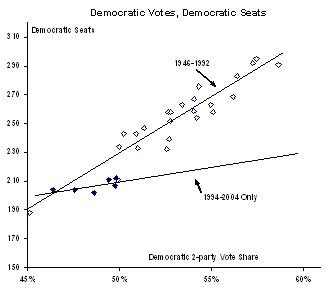by Andrew Kohut
One of the biggest political questions in the final weeks of this Congressional campaign is whether the national trend in support for Democratic candidates is big enough to overcome the safe-seat redistricting that in recent years has led to fewer and fewer seats turning over in Congress. Polls now show margins of support for the Democrats that historically would have been associated with winning a clear majority in the House.
But the political landscape is different than it was 15 years ago. Following the 1990 and 2000 censuses many districts were redrawn, using computer-assisted geopolitical mapping to maximize partisan homogeneity and decrease competitiveness. And it worked. In 2004 only 32 seats were won by less than 55 percent of the vote.
The chart below shows two trend lines. One tracks the relationship between the Democrats’ share of the two-party vote and U.S. House seats won by Democrats in the years 1946 through 1992. The other, with many fewer data points, tracks this same relationship in the years 1994 through 2004.



